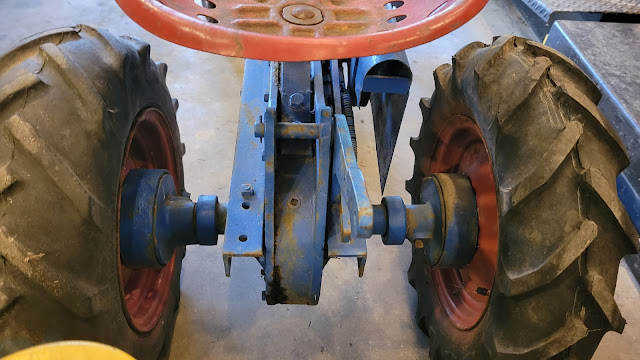Joining a tractor club has its benefits. It also has a downside. Namely, tractor club members usually have excess tractors taking up space at their residences. To that end, I bought two tractors in two consecutive days, from two tractor club members. I've posted about the Ferguson TO-35 but not about my new 1951 Baird Beaver. Just look at this cute little thing. The funky piece of steel poking out the front of the tractor is for a blade, which unfortunately didn't come with the tractor.
This tractor has a Wisconsin AKN 6-horse engine (most likely original to the tractor, although the serial number plate is missing). It's also got a single speed forward and reverse. The clutching system to go forward is simply tightening up a belt, kind of similar to my Gibson tractor. To go in reverse, a friction disc is engaged to a pulley, so no belt drive for reverse. The direction of the tractor is controlled by a foot pedal on the right side of the tractor (see below). Push the top of the pedal forward and the tractor will go forward. It has an over-center device that locks into place in forward. To go reverse, push the bottom of the pedal down until the friction disc engages a pulley.
This next photo below shows the cogged part and a pawl on the end of a shaft. Disregard the "W"-shaped thing. That's what people use to defeat the pawl drive. The cog part is fastened to the rear wheel. The pawl and shaft are driven by the rear axle. In the photo, the pawl is being driven in a clockwise direction and a weight rubbing on the rear axle housing (I'll call it a friction weight) keeps the pawl tipped into the cog. Then imagine if the wheel speeds up faster than what the pawl is spinning, the cogs simply ride past the pawl in a freewheeling motion. If you are freewheeling down a hill, it's only when the pawl is driven in a reverse direction that the friction weight causes the pawl to flop to the other side and start catching the cogs to slow you down.
The first hill I went down was fairly short but steep, and I just rode it out. I wasn't aware of this free-wheeling "feature" when I went down that first hill and it was a bit disheartening. At first I assumed the cogs/pawls were just gummed up and didn't work properly. I don't know why I thought the issue wouldn't happen a second time but I then I went down another, longer, hill and it did the same thing. I thought I could put my feet down like Fred Flintstone but decided I didn't want to have the rear tires run over my feet. All I could do was hold on and try to keep the tractor pointed straight. It was after that when I queried the Beaver Facebook page to see if something was amiss on my tractor. Nope, Beavers up until 1953 are this way. They made a change on the '53 and newer tractors that supposedly fixed the issue.
In the photo below, there are two rings on the axle housing. Those rings are the friction weights that act on the pawls.
The carburetor on the engine is not correct. Someone on the Beaver forum said it dates to around 1928-1936. Now that's a real antique. It still works though. I just can't fit an air cleaner to it because the carb opening is right next to the muffler.
The left front tire has holes in the sidewall so I couldn't pump it up (or the tube would extrude and pop). I have new front tires coming.
This next photo shows a better view of a friction weight.
Here's a short video of the tractor running and driving:










No comments:
Post a Comment